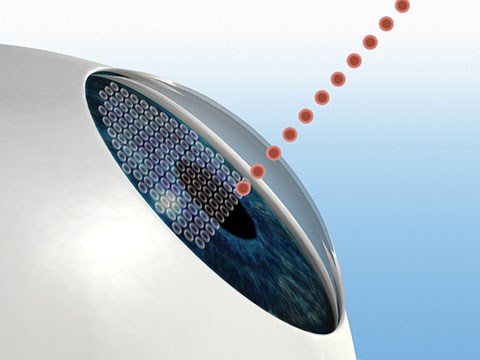IntraLase®
 The IntraLase Method Means Truly Blade-Free LASIK
The IntraLase Method Means Truly Blade-Free LASIK
The IntraLase Method is a 100% blade-free approach to creating your LASIK flap — the thin flap of tissue that the doctor creates to perform your LASIK procedure. The IntraLase Method can only be performed using the IntraLase Laser. Millions of procedures have been performed safely and effectively using the IntraLase Method. With the IntraLase Method, you can have a LASIK procedure that’s 100% blade free, exceptionally advanced, and has been shown to improve outcomes for more patients.
Amazing Technology
With the IntraLase Method, tiny pulses of laser light, a quadrillionth of a second each, pass harmlessly through the outer portion of your cornea and form a uniform layer of microscopic bubbles just beneath the surface of your eye. The IntraLase flap creation process takes about 15 to 20 seconds per eye and a total of 10 minutes for the entire LASIK procedure. When it’s time for your LASIK treatment to be performed, your doctor easily lifts the flap to apply the LASIK treatment.
Outstanding Results
The IntraLase Method also delivers outstanding results and has been shown to improve outcomes for more patients.1 In a clinical survey of LASIK patients who had their LASIK flaps created using a blade in one eye and the IntraLase Method in the other, the vision in the IntraLase-treated eye was preferred 3-to-1 (among those who stated a preference).2,3
- Tanna M, Schallhorn SC, Hettinger KA. Femtosecond laser versus mechanical microkeratome: a retrospective comparison of visual outcomes at 3 months. J Refract Surg. 2009;25 (7 Suppl):S668-71.
- Durrie DS. Randomized prospective clinical study of LASIK: IntraLase versus mechanical keratome. Subsets presented at: Meeting of the International Society of Refractive Surgery of the American Academy of Ophthalmology; November 14-15, 2003; Anaheim, CA; American Society of Cataract and Refractive Surgery Symposium; May 1-5, 2004; San Diego, CA; Refractive Surgery 2004; International Refractive Surgery: Science and Practice; October 22-23, 2004; New Orleans, LA; American Society of Cataract and Refractive Surgery Symposium; April 15-20, 2005; Washington, DC.
- Mahdavi S. IntraLase: coming of age. Cataract Refract Surg Today. 2005:117-20.
Additional Information
- iFS Laser Cataract Procedure (LCS) Patient Education Card
- iFS Laser Infograph
- iFS Precisely-Shaped Incisions for Corneal Transplants Infograph
- 2011 iFS Laser Positioning
Note: These files are in PDF format. If you do not have Adobe® Reader® on your computer, you can download it for free by clicking here.
IMPORTANT SAFETY INFORMATION
The FS and iFS Laser systems are ophthalmic surgical lasers indicated for use in patients undergoing surgery or treatment requiring the initial lamellar resection of the cornea. Contraindications may include corneal edema, glaucoma, and keratoconus. Risks and complications may include corneal pain, flap tearing, and epithelial ingrowth. Consult with your eye care professional for a complete listing of contraindications and risks. U.S. Federal Law restricts this device to sale, distribution, and use by or on the order of a physician or other licensed eye care practitioner.
©2010 Abbott Medical Optics Inc. Unless otherwise specified, all product names appearing in this Internet site are trademarks owned by or licensed to Abbott Laboratories, its subsidiaries or affiliates. No use of any Abbott trademark, trade name, or trade dress in this site may be made without the prior written authorization of Abbott Laboratories, except to identify the product or services of the company. 2010.05.20-IL2000.

 CONNECT
CONNECT
 The IntraLase Method Means Truly Blade-Free LASIK
The IntraLase Method Means Truly Blade-Free LASIK